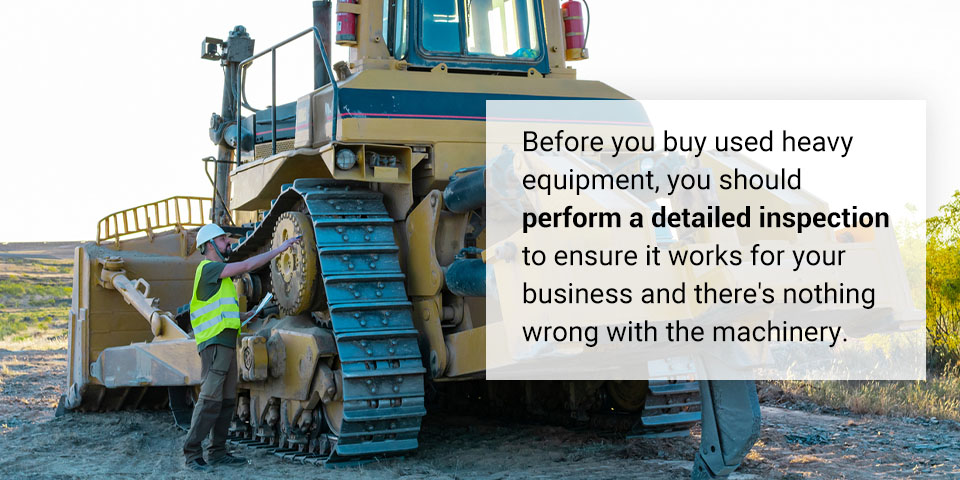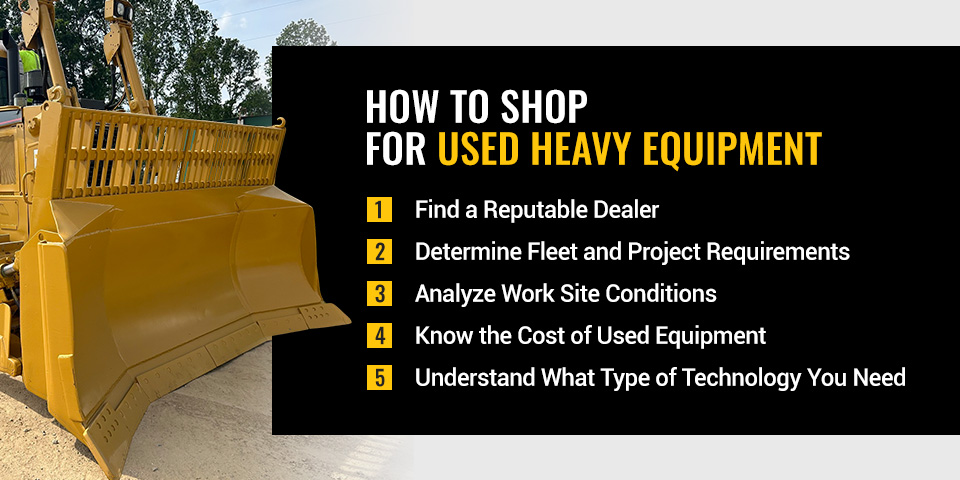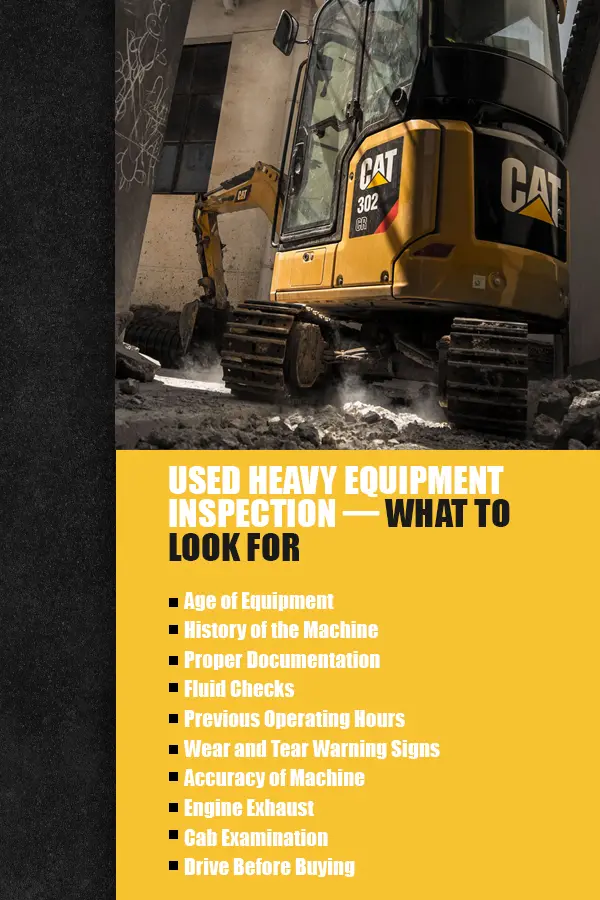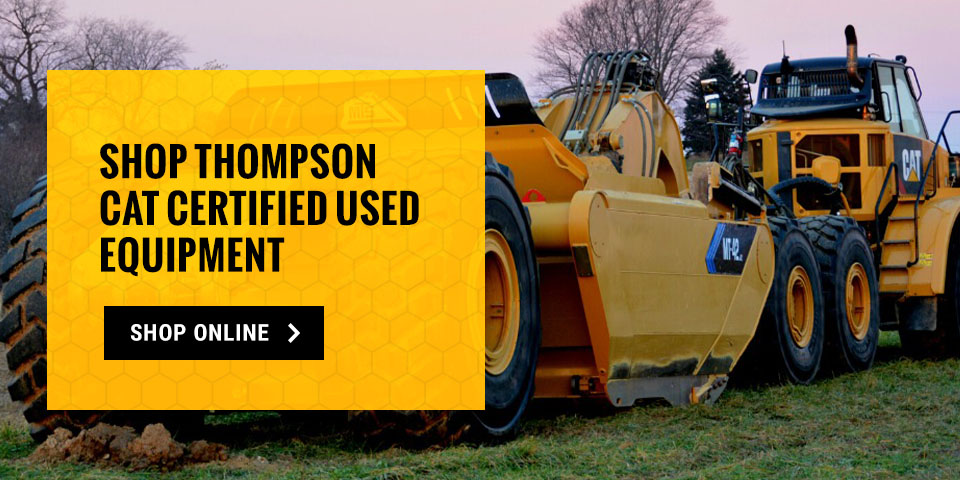Whether starting a business from the ground up or expanding your existing fleet, financing new equipment may not always be feasible. Buying used can be an excellent alternative, but it can be challenging to determine if you’re getting the best value. Our guide can help you learn to shop with confidence.
Buying used is different than buying new, and with the help of our experts at Thompson Tractor, we can help you find certified used equipment that maximizes your profits and increases your fleet’s efficiency and versatility. We can help you find top-quality equipment at or below your budget in our used equipment guide.
Used Heavy Equipment Buyer’s Guide
Used machines can perform the same tasks as new machines and often come equipped with the same features. However, there are warning signs you should look out for when receiving a machine secondhand.
Before you buy used heavy equipment, you should perform a detailed inspection to ensure it works for your business and there’s nothing wrong with the machinery. Hasty decisions could result in high maintenance costs, lengthy downtime, and equipment that doesn’t work. Our technicians can provide reliable guidance so you’re confident when purchasing heavy machinery.
Some of the key benefits of buying used equipment include:
- Limited depreciation: New heavy machinery will immediately depreciate when taken off the lot and can depreciate significantly within the first year. The value of new equipment can depreciate as much as 40% from the original price. After the initial loss, the value will usually plateau and remain steady. Used equipment has already undergone this depreciation phase, so you don’t need to worry about the value dropping.
- Excellent resale value: Used heavy equipment has stabilized in value, which makes it more likely for you to regain the value of the initial investment if you decide to sell, as long as you have properly maintained the equipment.
- Consistent operations: Well-maintained used equipment will operate as consistently as new equipment, so you won’t have to worry about downtime and poor efficiency on your work site.
Used equipment may have a lower price but may not include the competitive advantages of modern fleet management technology, updated safety features, or quality-of-life improvements such as a more comfortable cab space.
However, used heavy equipment can hold its value for years because the core functionality and operating power are still strong. A used piece of heavy equipment may perform comparably to a new piece of equipment at a fraction of the cost. This isn’t to say your business should avoid new tech when needed, but be mindful of the actual changes that can affect your bottom line.
The types of industries Thompson Tractor supports include:
- Agriculture
- Construction
- Earthmoving
- Forestry
- Governmental
- Landscaping
- Mining
- Paving
- Power systems
- Quarry and aggregate
- Waste
We work hard to provide solutions for every sector. Our inventory of used heavy equipment includes machines such as:
- Backhoes
- Compact track loaders
- Excavators
- Motor graders
- Skid steers
- Track type tractors
- Wheel loaders
Whether you’re looking for one machine or an entire fleet of used equipment, our experts are here to guide you through the process.
How to Shop for Used Heavy Equipment
While checking online sites for used machinery can seem quick and easy, it can’t be compared to working with a trusted dealer who offers support before, during, and after the sale. In addition to a dealer experience, other factors to consider when shopping for used equipment include fleet requirements, work site environments, cost, and essential technology.
Here are five steps to follow as you shop for used heavy equipment.
1. Find a Reputable Dealer
A reputable dealer with a good track record will have high-quality used heavy equipment that’s appropriately maintained. You can also partner with a dealer with financial programs and warranties to reduce maintenance and repair costs.
At Thompson Tractor, we ensure regular maintenance of our equipment and deliver quality-made equipment to make it simpler for you to find services and replacement parts. Caterpillar has modular components we can recondition or rebuild, too. You must find OEM parts for used heavy equipment because they’re engineered to work with your machines, allowing them to operate at full capacity. Choosing OEM used equipment replacement parts also benefits you financially because they’re usually covered by warranties, ensuring longer-lasting repairs.
2. Determine Fleet and Project Requirements
Consider what equipment you need for your projects to increase efficiency while ensuring the used equipment fits with your existing fleet. Understanding what equipment you need, including the attachments, capabilities, and engine size, can help you narrow your options for comparison. Once you know what you need, you can target specific brands and models.
Sometimes, bigger can be better for getting the job done faster, but it can increase operation and maintenance costs. Smaller versions have better maneuverability and fuel requirements but can be less efficient in certain situations. After you have a solid idea, research the going rate for the brand and model of the machine. You might end up with more than one option for your specifications.
Once you analyze the requirements of current and future jobs, you can develop a maximum bid that includes transportation costs.
3. Analyze Work Site Conditions
Your work environment, including the climate, seasonal hazards, and terrains, will factor into what equipment would be best. You can narrow down your equipment options by understanding your work atmosphere. For example, you may choose an enclosed cab if you work in extreme temperatures or a tracked machine for uneven terrain.
4. Know the Cost of Used Equipment
The upfront cost is what most managers see first before making a purchase. However, you also need to analyze the price of owning used machines. The price to own includes factors such as maintenance, insurance, transportation, fuel expenses, and more. Calculate how it fits into your budget and future expectations.
5. Understand What Type of Technology You Need
You can add other forms of technology to machines, such as telematics devices. Consider your projects and determine what level of tech you need. Are they simple, or do they require logistics and telematics?
The latest technology also may not be an option with all used equipment, and availability will generally be lower than new machines. Choose the device that best facilitates your work site, and consider investing in more popular models to find replacement parts more easily. Buying specialty equipment means you have to search for unique pieces. Excavators, cranes, and dozers are more common and accommodate new and used OEM parts.
Used Heavy Equipment Inspection — What to Look For
We created an inspection checklist for used heavy equipment to support you in finding the ideal machinery. What may seem tedious will only help you make the best investment for your company. From checking fluids and documents to inspecting signs of wear and the hours used by the previous owner, used equipment inspection can deter you from making a hefty purchase that results in unknown repairs.
The best advice we can give is always to select well-maintained engines. Here are 10 factors to consider to differentiate between a neglected and well-cared-for machine.
1. Age of Equipment
Knowing the used equipment’s age can help you estimate how long it will last after your purchase. It also presents an idea of how much it’s worth. An older machine may only have a few years left, while a newer machine can serve you longer.
The age also shows how much maintenance you need and even helps illuminate parts that may go bad within the next several years. From here, you can factor in replacement and repair costs when looking at the asking price of the used machine.
2. History of the Machine
The history of heavy equipment can help you determine its quality. For example, you’ll want to look at the logged hours and miles and if the equipment was used responsibly. A responsibly used machine will be in better shape with a longer life span. But one used recklessly will default quicker and possibly cause more problems down the line. Check out the body for damage like dents and other factors that show how hard it was used and aspects like fluids and exhaust.
3. Proper Documentation
While evaluating the physical condition of the engine is crucial, ensuring proper documentation also plays a significant role. Are there any liens against the machine? Can the dealer verify reliability? Always ask for used equipment maintenance records and a list of completed major services. You can gain info from the papers like fluid change intervals, the average frequency of maintenance problems, and occurrences of severe problems.
Also, check that the suspension, hydraulic, engine and transmission components were serviced and examine the oil-sampling records. The documentation distinguishes between negligence and proper upkeep, which can make or break the deal.
4. Fluid Checks
As you’re walking around the equipment, be sure to check the inside fluid components. Evaluating engine fluids like the transmission, engine oil, coolant, and hydraulic liquids will give insight into how the machine was maintained and its current conditions.
Dirty and low fluids in the gaskets can indicate poor upkeep and below-standard maintenance. Be aware of other concerning conditions, such as water in engine oil, which can relate to more critical issues. Others include cloudy oil, a coolant system with bubble formations, and oil in coolant or vice versa.
These problems can relate to more extreme engine malfunctions, like a blown head gasket, resulting in costly repairs. Additional replacements on top of the asking price can add up to where you may be paying more than you bargained for.
5. Previous Operating Hours
Used equipment hours aren’t an all-or-nothing consideration but paint an idea of which end the machine is on — whether it’s at its last leg or if it can run for years to come. The best way to know if the previous hours are a significant factor is to calculate the cost/benefit. You can see if saving money is worth the extra maintenance and the possibility of the equipment breaking down more often. You can also check the mileage on the odometer to understand how much it has run.
While numbers often equal liable statistics, they may not be all of what they seem. High hours can impact the value of a diesel engine by resulting in decreased performance, usually requiring extra maintenance and resulting in reduced secondhand life.
However, even with many hours of use, if the former owner maintained and cared for the equipment, it can still deliver high performance. If the operating hours are close to the engine’s upper limits, it can still benefit less demanding projects.
6. Wear and Tear Warning Signs
Wear is inevitable with used equipment, but the degree can indicate regular upkeep vs. severe damage. Some repairs can add value, but others can indicate disregard if completed just before selling. Examining the equipment can help you determine what future repairs may look like. Look for warning signs like:
- Coolant in oil and oil in coolant
- Difficult engine starting
- Foam in fluid reservoirs
- High temperatures in the system
- Loose pins in the undercarriage
- Oil leaks on or under equipment
- Smoking engine
- Structural damage
- Welds on attachment arms
Of course, a used piece of equipment won’t be as pristine as a new engine from the market, but some signs of wear can indicate problems, including:
- Rust
- Decay
- Dents
- Repair welds
- Damaged parts
- Hairline cracks along the steel
Wear and tear can lead to future breakdowns and hazards, creating downtime. While small issues may not affect the equipment’s performance, other problems can cause significant problems in the future.
Check the engine and transmission for smoke when starting. Examine the chassis for wear on the mounts, bearings, or spring coils. Does it start and stop as it should? Look at the hydraulics and work tool attachments for welds and signs of dramatic damage. Check for worn tracks or tires.
7. Accuracy of Machine
Watch out for the accuracy and precision of the technology, attachments, and general operation of the industrial equipment. Once compromised, it can lead to errors that impact the project and your business. Operating inaccurate machinery can risk your worker’s safety and place a setback on your jobs.
8. Engine Exhaust
When you power on the engine during the test drive, take notice of different noises and vibrations — feeling, hearing and seeing how the engine functions can tell you various conditions. In particular, the exhaust can indicate the health of the equipment’s internal components. Check for symptoms like black, white, or blue smoke:
- Black smoke: Black smoke indicates an imbalanced mix of air and fuel inside the engine triggered by inadequate filtration.
- White smoke: White smoke results from mixed fluids like coolant and water spreading in the oil from a blown head gasket.
- Blue smoke: Blue smoke indicates a broken ring or valve seal that lets in too much oil, causing the engine to overheat.
High costs to make any of these repairs may outweigh the value of the machine.
9. Cab Examination
The driver region can also show how the equipment was cared for. See if the sticks, pedals, gears, and dashboard aspects work and if the seat and steering are functional. Even having clean upholstery that’s intact can be a sign of proper upkeep. Is the cab comfortable? Are the controls easy to operate? Can you feel any excessive vibration?
10. Drive Before Buying
Sometimes, the best way to see used heavy equipment maintenance is to test drive the machine like you would with a car. Survey its abilities by performing a test load with a pile of rocks or dirt. Feel for different performance indicators of the engine by looking and listening for grinding or clunking sounds and vibrations. Are there glares in the glass that can affect visibility? Are there any visible fluid or oil leaks?
Make sure to test every speed and movement of the equipment with its appropriate attachments. You can even examine the tightness of the controls, such as the rod, control handle, rocker arm, knob, springs, and bushings.
How to Calculate the Total Price to Own
The total cost of ownership goes beyond the price you read on the price tag. You’ll also need to consider other factors, such as maintenance, downtime, and operational cost. You can calculate the total cost to own (TCO) by using the following calculation:
- TCO = initial cost + cost of operation + cost of maintenance + cost of downtime + cost of production – remaining value
The breakdown of these cost calculations and what they mean includes:
- Initial cost: The initial cost is the price you pay for the machine.
- Operation costs: Operation costs include the money spent on fuel and other aspects that keep the engine running.
- Maintenance costs: Maintenance is the expense of regular upkeep, including cleaning, adjustments, repairs, and replacements.
- Downtime costs: Downtime is the cost of lost production but can include lost customers and delayed employee work.
- Production costs: The production cost is how much time you spend on projects, including labor, fuel, and materials.
- Remaining value: The remaining value is what your used equipment is worth after several years of operation.
The price to own used heavy equipment plays a significant role in making a final acquisition. Considering all the factors to recognize what you’re paying for is critical. Looking at the collective list of expenses will help you compare equipment, so you can see what to expect after the sale and how to prepare.
Seeing the big picture allows you to budget and adjust your fleet if needed. Knowing how much goes into the total cost of ownership, do you need to cut back on fuel use? Do your projects need a boost in efficiency? Do you need to cut a percentage of downtime? The total price to own gives you an overall perspective on the sale.
Used Heavy Equipment Financing
Used equipment sales are a great alternative when brand new is not feasible — or even practical for your venture. However, the upfront cost may still cause some uncertainties with used machines, especially if you’re starting to lift your business off the ground.
If available, your best option is to take advantage of equipment financing options or a rent-to-buy program. Thompson Tractor is here to support your growth. We know you strive to be productive and profitable, so you need flexible financing solutions, quick funds, and fewer fees.
We provide solutions that protect your equipment and deliver support that goes above the norm, and we offer various options when purchasing, like low interest rates and refinancing programs.
Shop Thompson Cat Certified Used Equipment
Thompson Tractor is a full-service provider for sales, parts, service, rental, technology, fluids analysis, and power solutions. It can’t get any better than partnering with a dealer with everything you need. With an advancing inventory to include more safety-enhancing features, we are an industry leader that knows your business and particular needs. Thompson provides exceptional support, knowledge, and services through our trustworthy and experienced team of experts.
From business owners and fleet managers to construction project advisers, we partner with you to supply incredible value for used machinery. When you have unmatched support during and after the buying process, choosing Thompson becomes second nature for operations in Alabama and northern Florida.
Shop for used equipment on the Thompson Tractor site, inquire about used equipment or contact us online for more details about our used equipment and financing programs.





